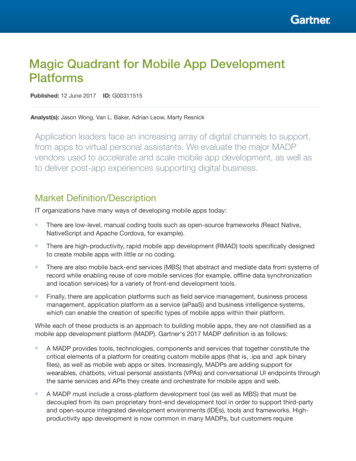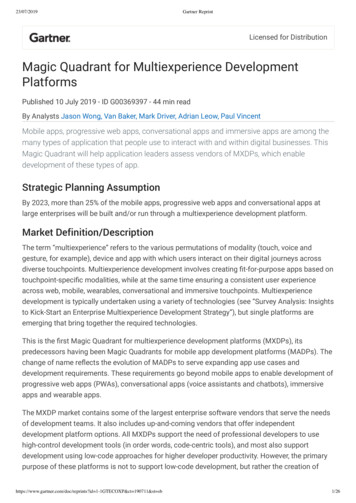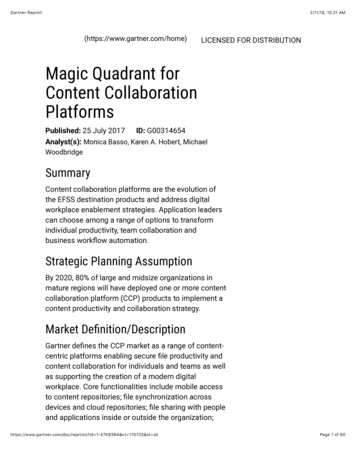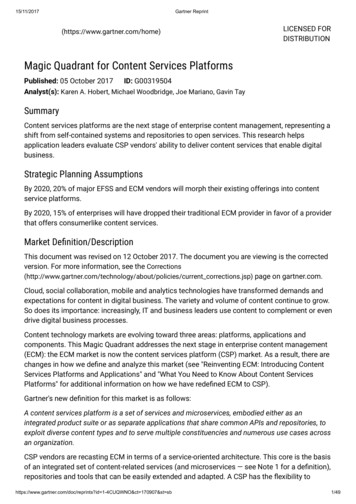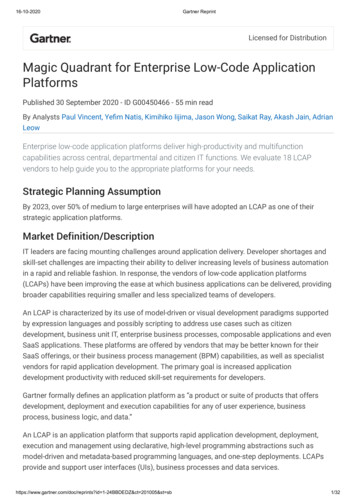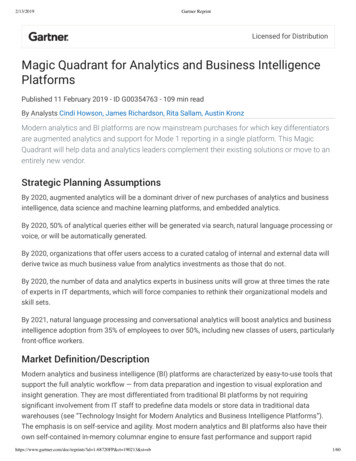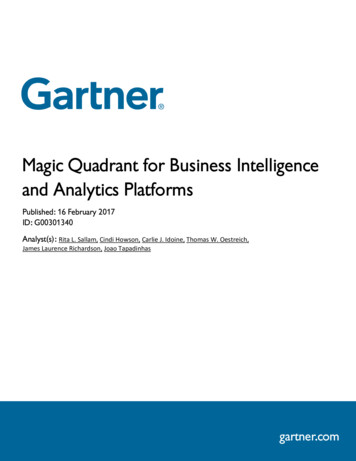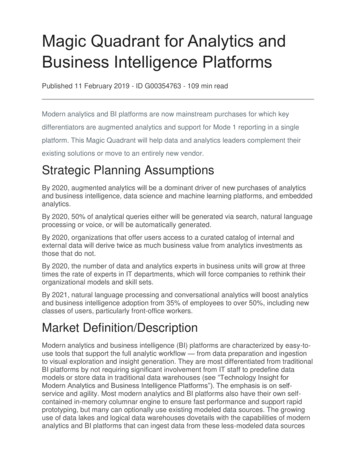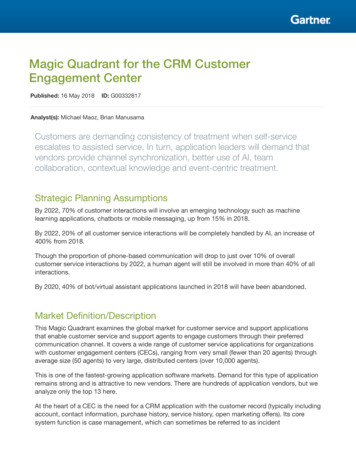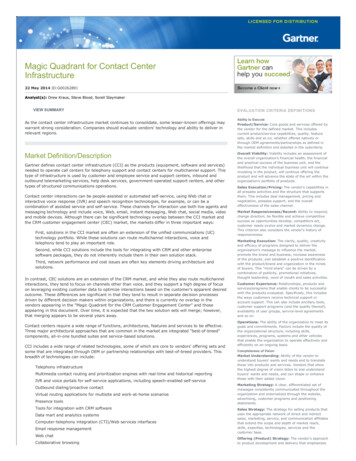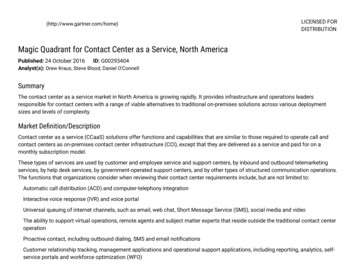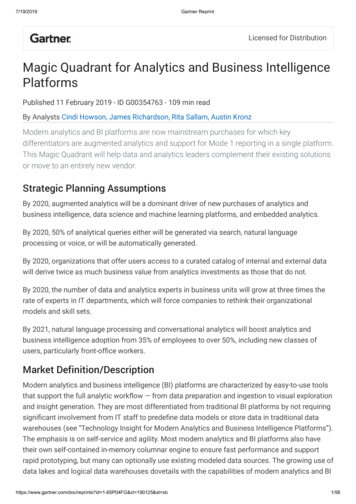
Transcription
7/19/2019Gartner ReprintLicensed for DistributionMagic Quadrant for Analytics and Business IntelligencePlatformsPublished 11 February 2019 - ID G00354763 - 109 min readBy Analysts Cindi Howson, James Richardson, Rita Sallam, Austin KronzModern analytics and BI platforms are now mainstream purchases for which keydifferentiators are augmented analytics and support for Mode 1 reporting in a single platform.This Magic Quadrant will help data and analytics leaders complement their existing solutionsor move to an entirely new vendor.Strategic Planning AssumptionsBy 2020, augmented analytics will be a dominant driver of new purchases of analytics andbusiness intelligence, data science and machine learning platforms, and embedded analytics.By 2020, 50% of analytical queries either will be generated via search, natural languageprocessing or voice, or will be automatically generated.By 2020, organizations that offer users access to a curated catalog of internal and external datawill derive twice as much business value from analytics investments as those that do not.By 2020, the number of data and analytics experts in business units will grow at three times therate of experts in IT departments, which will force companies to rethink their organizationalmodels and skill sets.By 2021, natural language processing and conversational analytics will boost analytics andbusiness intelligence adoption from 35% of employees to over 50%, including new classes ofusers, particularly front-office workers.Market Definition/DescriptionModern analytics and business intelligence (BI) platforms are characterized by easy-to-use toolsthat support the full analytic workflow — from data preparation and ingestion to visual explorationand insight generation. They are most differentiated from traditional BI platforms by not requiringsignificant involvement from IT staff to predefine data models or store data in traditional datawarehouses (see “Technology Insight for Modern Analytics and Business Intelligence Platforms”).The emphasis is on self-service and agility. Most modern analytics and BI platforms also havetheir own self-contained in-memory columnar engine to ensure fast performance and supportrapid prototyping, but many can optionally use existing modeled data sources. The growing use ofdata lakes and logical data warehouses dovetails with the capabilities of modern analytics and BIhttps://www.gartner.com/doc/reprints?id 1-65P04FG&ct 190125&st sb1/58
7/19/2019Gartner Reprintplatforms that can ingest data from these less-modeled data sources (see “The Practical LogicalData Warehouse: A Strategic Plan for a Modern Data Management Solution for Analytics”).The crowded analytics and BI market includes everything from long-standing and largetechnology players to startups backed by venture capital and smaller, privately funded softwarevendors. Vendors of traditional BI platforms have evolved their capabilities to include modern,visual-based data discovery that also includes governance, and more recently, augmentedanalytics. Newer vendors continue to evolve the capabilities that once focused primarily on agility,by extending them to enable greater governance and scalability, as well as publishing and sharing.The holy grail is for customers to have both Mode 1 and Mode 2 capabilities (see Note 1) in asingle, seamless platform that draws on existing assets but also has emerging best-of-breedcapabilities.As disruptive as visual-based data discovery has been to traditional BI, a third wave of disruptionhas emerged in the form of augmented analytics, with machine learning (ML) generating insightson increasingly vast amounts of data. Augmented analytics also includes natural languageprocessing (NLP) as a way of querying data and of generating narratives to explain drivers andgraphics. Vendors that have augmented analytics as a differentiator are better able to commandpremium prices for their products (see “Augmented Analytics Is the Future of Data andAnalytics”).This Magic Quadrant focuses on products that meet Gartner’s criteria for a modern analytics andBI platform (see “Technology Insight for Modern Analytics and Business Intelligence Platforms”).It is this type of platform that accounts for the majority of net new mainstream purchases in theanalytics and BI platform market. Products that do not meet our criteria for a modern platform —either because of the upfront requirements for IT to predefine data models, or because they arereporting-centric — are covered in our “Market Guide for Traditional Enterprise ReportingPlatforms.”This Magic Quadrant refers throughout to composite measures of success based on a survey ofvendors’ reference customers. Reference customers scored vendors on each of the metricsdefined in Note 2 (see also the Evidence section). Opinions from Gartner Peer Insightscontributors are also factored into our assessments; these contributors are referred to as GartnerPeer Insights reviewers.The Five Use Cases and 15 Critical Capabilities of an Analytics and BI PlatformWe define and assess product capabilities across the following five use cases: Agile, centralized BI provisioning: Supports an agile IT-enabled workflow, from data to centrallydelivered and managed analytic content, using the platform’s self-contained data managementcapabilities. Decentralized analytics: Supports a workflow from data to self-service analytics, and includesanalytics for individual business units and users.https://www.gartner.com/doc/reprints?id 1-65P04FG&ct 190125&st sb2/58
7/19/2019Gartner Reprint Governed data discovery: Supports a workflow from data to self-service analytics to system ofrecord (SOR), IT-managed content with governance, reusability and promotability of usergenerated content to certified data and analytics content. OEM or embedded analytics: Supports a workflow from data to embedded BI content in aprocess or application. Extranet deployment: Supports a workflow similar to agile, centralized BI provisioning for theexternal customer or, in the public sector, citizen access to analytic content.We assess vendors on the 15 critical capabilities listed below. (Any changes to the previous year’scritical capabilities are listed in Note 3. Subcriteria for each capability are published in “Toolkit:Analytics and BI Platform RFP.” How well vendors’ platforms support these critical capabilities isexplored in greater detail in “Critical Capabilities for Analytics and Business IntelligencePlatforms.”)Infrastructure1. BI platform administration, security and architecture: Capabilities that enable platformsecurity, administering of users, auditing of platform access and utilization, and highavailability and disaster recovery.2. Cloud BI: Platform-as-a-service and analytic-application-as-a-service capabilities for building,deploying and managing analytics and analytic applications in the cloud, based on data both inthe cloud and on-premises.3. Data source connectivity and ingestion: Capabilities that enable users to connect to structuredand unstructured data contained within various types of storage platform (relational andnonrelational), both on-premises and in the cloud.Data Management4. Metadata management: Tools enabling users to leverage a common semantic model andmetadata. These should provide a robust and centralized way for administrators to search,capture, store, reuse and publish metadata objects such as dimensions, hierarchies, measures,performance metrics/key performance indicators (KPIs), and to report layout objects,parameters and so on. Administrators should have the ability to promote a business-userdefined data mashup and metadata to the SOR metadata.5. Data storage and loading options: Platform capabilities for accessing, integrating,transforming and loading data into a self-contained performance engine, with the ability toindex data, manage data loads and refresh scheduling.6. Data preparation: “Drag and drop” user-driven data combination of different sources, and thecreation of analytic models such as user-defined measures, sets, groups and hierarchies.Advanced capabilities include machine learning-enabled semantic autodiscovery, intelligenthttps://www.gartner.com/doc/reprints?id 1-65P04FG&ct 190125&st sb3/58
7/19/2019Gartner Reprintjoins, intelligent profiling, hierarchy generation, data lineage and data blending on varied datasources, including multistructured data.7. Scalability and data model complexity: The degree to which the in-memory engine or indatabase architecture handles high volumes of data, complex data models, performanceoptimization and large user deployments.Analysis and Content Creation8. Advanced analytics for citizen data scientists: Enables users to easily access advancedanalytics capabilities that are self-contained within the platform, through menu-driven optionsor through the import and integration of externally developed models.9. Analytic dashboards: The ability to create highly interactive dashboards and content withvisual exploration and embedded advanced and geospatial analytics for consumption byothers.10. Interactive visual exploration: Enables the exploration of data via an array of visualizationoptions that go beyond those of basic pie, bar and line charts to include heat and tree maps,geographic maps, scatter plots and other special-purpose visuals. These features enable usersto analyze and manipulate data by interacting directly with a visual representation of it, todisplay it as percentages, bins and groups.11. Augmented data discovery: Automatically finds, visualizes and narrates important findingssuch as correlations, exceptions, clusters, links and predictions in data that are relevant tousers without requiring them to build models or write algorithms. Users explore data viavisualizations, natural-language-generated narration, search and natural language query (NLQ)technologies.12. Mobile exploration and authoring: Enables organizations to develop and deliver content tomobile devices in a publishing and/or interactive mode, and takes advantage of mobiledevices’ native capabilities, such as touchscreen, camera and location awareness.Sharing of Findings13. Embedding of analytic content: Capabilities including a software developer kit with APIs andsupport for open standards for creating and modifying analytic content, visualizations andapplications, embedding them in a business process and/or an application or portal. Thesecapabilities can reside outside the application, reusing the analytic infrastructure, but must beeasily and seamlessly accessible from inside the application without forcing users to switchbetween systems. The capabilities for integrating analytics and BI with the applicationarchitecture will enable users to choose where in the business process the analytics should beembedded.14. Publish, share and collaborate on analytic content: Capabilities that enable users to publish,deploy and operationalize analytic content through various output types and d 1-65P04FG&ct 190125&st sb4/58
7/19/2019Gartner Reprintmethods, with support for content search, scheduling and alerts. These capabilities enableusers to share, discuss and track information, analysis, analytic content and decisions viadiscussion threads, chat and annotations.Overall Platform15. Ease of use, visual appeal and workflow integration: The ease of administering and deployingthe platform, creating content, and consuming and interacting with content, as well as thedegree to which the product is visually appealing. This capability also considers the degree towhich capabilities are offered in a single, seamless product and workflow, or across multipleproducts with little integration.Magic QuadrantFigure 1. Magic Quadrant for Analytics and Business Intelligence Platformshttps://www.gartner.com/doc/reprints?id 1-65P04FG&ct 190125&st sb5/58
7/19/2019Gartner ReprintSource: Gartner (February 2019)Vendor Strengths and CautionsBirstBirst provides an end-to-end data warehouse, reporting and visualization platform built for thecloud. Birst was an early cloud-native vendor, but also offers its product as an on-premisesappliance running on commodity hardware.In 2017, Birst was acquired by Infor. It now operates as a stand-alone subdivision within Infor.Infor has been gradually replacing its packaged analytic applications for Infor’s businessapplication solutions (previously built with IBM Cognos) with Birst, dubbing the new applicationsBirst for CloudSuite. The Birst analytics and BI team, meanwhile, has gained a global footprint,additional sales representatives and data science talent. Birst’s new Smart Analytics capabilities,powered by Coleman AI, were on limited release in 4Q18.https://www.gartner.com/doc/reprints?id 1-65P04FG&ct 190125&st sb6/58
7/19/2019Gartner ReprintBirst is a Niche Player in this Magic Quadrant. Birst’s reference customers primarily use itsplatform for agile, centralized BI provisioning (58%). The next most common use is fordecentralized analytics (45%).Strengths Cloud-native support for Mode 1 and Mode 2: Birst provides data preparation, dashboards,visual exploration and formatted, scheduled reports on a single platform. Few other vendorssupport both usage styles in this way. The networked semantic layer enables business units tocreate data models that can then be promoted to the enterprise. A new orchestration capabilityenables this content to be replicated to multiple instances. Birst supports live connectivity toon-premises data sources. However, its rapid creation of a data model and all-in-one datawarehouse that can draw on a range of storage options (Microsoft SQL Server AnalysisServices, SAP HANA, Amazon Redshift) is a unique selling point. Sixty-one percent of Birst’ssurveyed reference customers use Birst as their only analytics and BI standard. Vertical applications: Birst for CloudSuite now gives Infor ERP customers prebuilt extraction,transformation and loading (
This Magic Quadrant focuses on products that meet Gar tner ’s criteria for a modern analytics and BI platform (see “Technology Insight for Modern Analytics and Business Intelligence Platforms” ). It is this type of platform that accounts for the majority of net new mainstr eam purchases in the analytics and BI platform mark et. Products .
